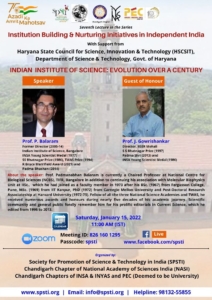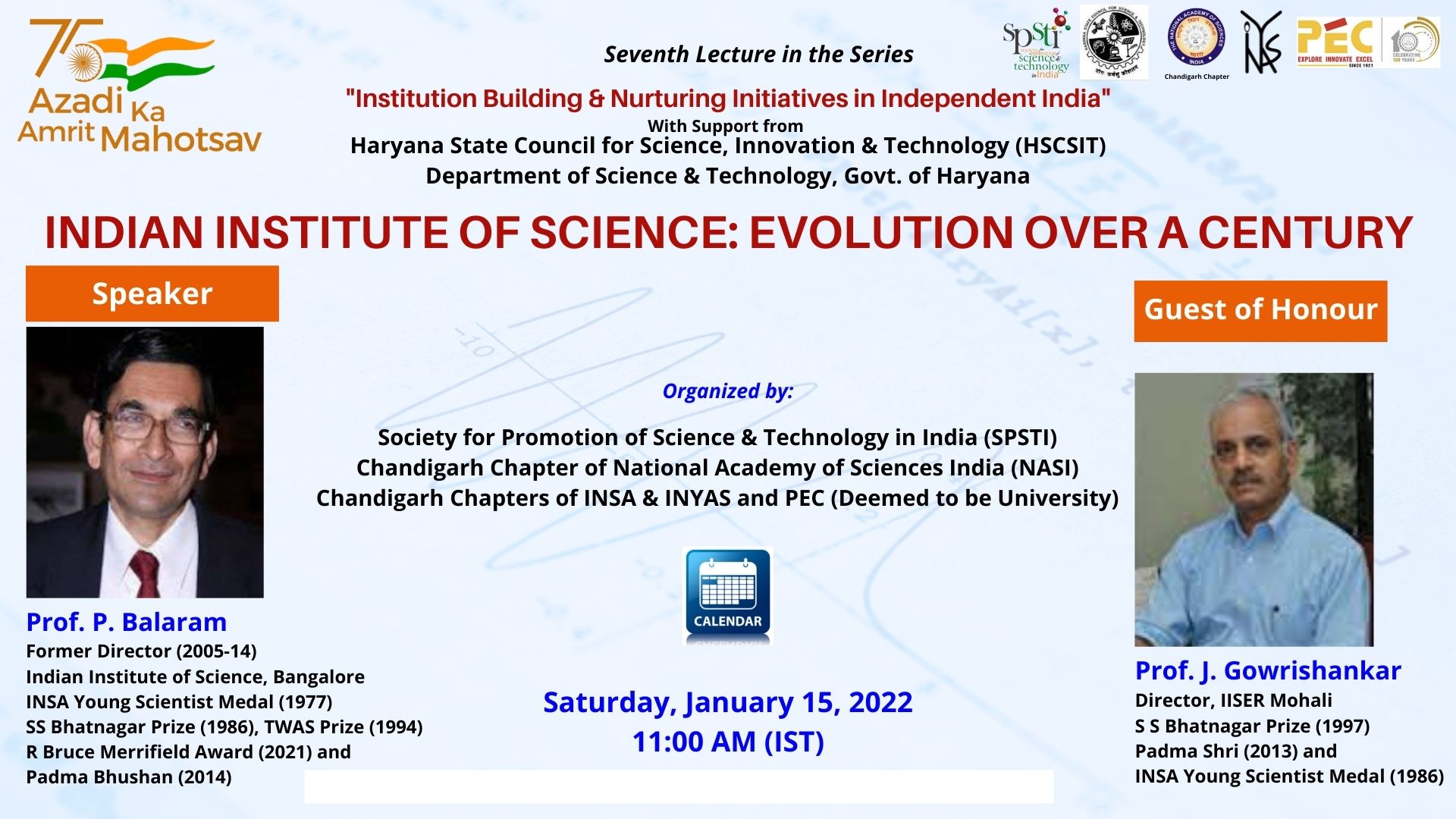“Nothing Like it in India, Nothing Better in Britain”
In 1959, Dr. Bhagvantam, director of the Indian Institute of Science, Bangalore, described it thus to Prof. Morris Travers, its first Director (1911 – 1914). The famed Institution which today draws top reserchers not only from India but also from beyond its shores, was the subject of a lecture (webinar) organized by the Society for Promotion of Science of Science & Technology in India (SPSTI), with Chandigarh Chapter of the National Academy of Sciences India (NASI) and Chandigarh chapters of INSA & INYAS in association with Punjab Engineering College (PEC) (Deemed to be University), Chandigarh with support from Haryana State Council for Science, Innovation & Technology (HSCSIT), DST, Govt. of Haryana. It was the seventh of the Eighteen part Lecture series devoted to ‘Institution Building & Nurturing Initiative in Independent India’ to commemorate Azadi ka Amrit Mahotsav. The lecture entitled “Indian Institute of Science: Evolution over a Century” was delivered by Padma Bhushan Prof. P. Balaram, Former Director, IISc Bangalore on January 15, 2022 at 11.00 am through online mode. The session was attended online on zoom and many more viewed the same on the Facebook page of SPSTI.
While commemorating 75 years of Indian independence it is useful to look at the decades which came before, when foundations of many institutions were laid. Prof. Balaram said Jamsetji Tata must be remembered as one of the remarkable Indians of the 19th century, much of whose vision was realized by his successors during the 20th century. In 1892 Jamsetji met Swami Vivekananda who was going to deliver a talk about religion in Chicago. In 1896, he wrote a letter to the governor outlining of proposals and in 1898 it was presented to Lord Curzon. Along with this, he wrote the letter to Vivekananda.
The Indian Institute of Science came into existence on May 27th, 1909 formally. It was a three way collaboration between House of Tatas, Government of India (the British government) and the Maharaja of Mysore. The Institute then had only two departments – General and Applied Chemistry and Electrotechnology, reflecting the two things important for the industrialization of India at the beginning of 20th century. Besides Jamsetji Tata, Lord Curzon, Swami Vivekananda, Burjorji Padshah and Sister Nivedita were major characters in the story of IISc. He shared many letters, accumulated laboriously by him from various archives, exchanged in the process of establishing IISc. Lord Curzon reportedly said, when he saw the Tata proposal, “To start with polytechnics, and so on, is like presenting a naked man with a top hat when what he wants is a pair of trousers.” The complex interplay between Indian and British leaders, who were influenced by different traditions of higher education throughout the world, as seen in the 16 years struggle to realize J.N. Tata’s dream, is a missing chapter in the study of higher education in India. Lord Raeay, the Governor, Padshah and William Travers also contributed to its establishment. The grant needed for building the institute came from the Government and the land from the Maharaja of Mysore, who also gave a large monetary grant. The speaker also shared how Bangalore was selected in preference to Rurki! Padshah was in correspondence with Sir William Ramsay, the Nobel Laureate Chemist, who suggested thet Travers be appointed as the Director. Prof. Balaram also talked about the governing council at that time that included viceroy as the patron and the vice patrons being the governors of the various provinces giving the institute its resilience.
In a 1912 a memorial to Jamshetji Tata was erected and in 1922 his statue was built in the Institute. The institutions that have emerged from the Indian Institute of Science are Tata Institute of Fundamental Research, Mumbai; HAL, Bangalore; ISRO; Central Food Technology Research Institute, Mysore; National Centre for Biological Sciences, Bangalore and Jawaharlal Nehru Centre for Advanced Scientific Research, Bangalore. He concluded by saying it was the vision of Jamsetji Tata who conceived the idea of India’s most accomplished and most visible institution.
Earlier Dr. Sanjeev Khosla, Director, IMTECH introduced the Guest of Honour, Padma Shri Prof. Gowri Shankar, Director, IISER Mohali. The speaker was introduced by Prof. R. Kishor Srivastava, IMTECH.The session was much appreciated by the audience and followed with intense discussions and questions. Shri Dharam Vir, IAS (Retd.), the President of SPSTI presented the vote of thanks. Others present on the occasion were Prof. Keya Dharamvir, General Secretary, SPSTI, Ms. Rajni Bhalla. Prof. Arun Kumar Grover, Former Vice Chancellor of Panjab University and Vice President of SPSTI .
Watch complete video here


